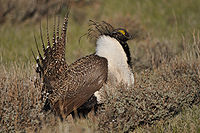Greater Sage Grouse
 From Conservapedia
From Conservapedia | Greater sage grouse | |
|---|---|

| |
| Scientific classification | |
| Kingdom Information | |
| Domain | Eukaryota |
| Kingdom | Animalia |
| Branch | Deuterostomia |
| Phylum Information | |
| Phylum | Chordata |
| Sub-phylum | Vertebrata |
| Infraphylum | Gnathostomata |
| Class Information | |
| Superclass | Tetrapoda |
| Class | Aves |
| Order Information | |
| Superorder | Galloanserimorphae |
| Order | Galliformes |
| Sub-order | Phasiani |
| Family Information | |
| Superfamily | Phasianoidea |
| Family | Phasianidae |
| Genus Information | |
| Genus | Centrocercus |
| Species Information | |
| Species | C. urophasianus |
| Population statistics | |
| Population | 150,000 (2004; decreasing) |
| Conservation status | Near-threatened[1] |
The Greater sage-grouse (Centrocercus urophasianus) is a large, chicken-like bird of the western plains of North America, dependent on the sagebrush for existence.
Description[edit]
The Greater sage-grouse is a rounded-winged, ground-dwelling bird, approximately 30 inches long, standing 2 feet tall, and weighing from two to seven pounds. Both sexes are a mottled brown, black, and white. Males are slightly larger, and during mating displays they have a large white ruff around their neck and bright yellow, inflatable air sacks on their breasts. Tail feathers in males are longer with pointed shafts, and are fanned out during displays.
Range and habitat[edit]
Greater sage-grouse are found at elevations of between 4,000 and over 9,000 feet in the western Great Plains, the Great Basin of Nevada, and westward into the plains areas of Washington, Oregon, eastern California, and north into Alberta and Saskatchewan.
The birds are dependent on the sagebrush (Artemisia spp.), for food, cover, and nesting sites; it has been determined that they cannot exist without these plants.
References[edit]
↧ Download as ZWI file | Last modified: 02/17/2023 19:39:02 | 8 views
☰ Source: https://www.conservapedia.com/Greater_sage_grouse | License: CC BY-SA 3.0
 ZWI signed:
ZWI signed: KSF
KSF